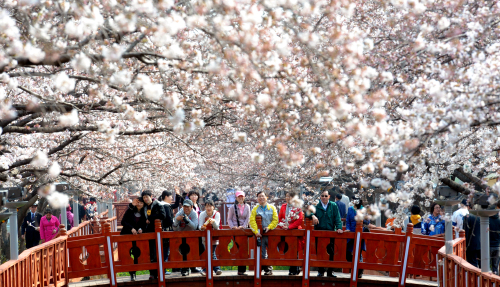Korea is apparently already under the influence of global warming as flowers are blooming earlier than ever, a state-run institute said Thursday.
At the same time Fall leaves are coming later, indicating that the climate here is getting warmer and milder, said Lee Kyeong-mi, staff worker at the National Institute of Meteorological Research.
 |
Cherry blossoms in full bloom in Jinhae, South Gyeongsang Province, last spring. (Ahn Hoon/The Korea Herald) |
Lee found that the flowering of Japanese apricot plants has come forward 4.1 days in the past decade, which suggests that spring is arriving on the Korean Peninsula increasingly early.
The blossoming of forsythia, azalea, cherry blossom, peach tree and pear tree have come forward one day, 1.8 days, 2.1 days, 1.6 days and 2.1 days, respectively, in the cited period.
“The blossoming of Japanese apricots, in particular, hadn’t shown any change of time until the 1980s. But since the 1980s, it has advanced by 14 days, which is alarming,” Lee said.
“The rise of temperature ― the monthly increase by 0.54 degrees Celsius in February and 0.39 degrees in March for the past 10 years ― has contributed to the advancement,” she said.
The period of gingko blossoming went back 3.7 days between 1989 and 2007. A similar pattern was detected for maple foliage, which has been delayed by 4.1 days during the same period.
“The blossoming period of plants is a barometer and indicator of global warming and other climate change factors,” Lee said.
This is not the first time climate change has been seen to be affecting Korea, and some experts have claimed that Korea might become a subtropical zone.
The National Institute of Environmental Research said last year that the average temperature of the Korean Peninsula between 1991 and 2000 marked 13.5 degrees, about 1.5 degrees up from 12 degrees recorded between 1912 and 1990. The pace of the rise was about 2.5 times faster than the global average, the institute said.
The Korea Forest Research Institute last year found two species of subtropical plants on the southern island of Jeju.
“The discovery shows that Korea has already stepped into the hot and humid zone,” said Kim Chan-soo, who headed the research.
By Bae Ji-sook (
baejisook@heraldcorp.com)
<관련기사>
"한반도 매화 10년에 4일씩 빨리 핀다"
국립기상연구소 이경미 연구원 박사학위 논문서 발표
지구 온난화 등 기후변화로 한국의 봄철 개화 시기가 점차 빨라지고 있다는 연구 결과가 나왔다.
국립기상연구소 이경미(31·여) 연구원은 건국대 지리학과 박사학위 논문 '한반도 식물 계절과 기후에 관한 연구'에서 서울과 강릉, 제주 등 전국 14개 역의 식물 개화, 발아 시기와 단풍 절정일 등이 기록된 기상청 자료를 분석, 이런 결과를 얻었다고 24일 밝혔다.
연구는 1960∼1970년 매화, 개나리, 진달래 등 7종의 발아, 개화 시기와 기후
변화 사이의 상관관계를 분석하는 방식으로 이뤄졌다.
2월과 3월의 평균 기온이 10년에 각각 0.54도, 0.39도 상승한 이 기간에 매화 개화일은 10년에 4.1일의 비율로 점차 앞당겨지는 경향을 보였다.
개나리는 10년에 1일, 진달래는 1.8일, 벚꽃은 2.1일, 복숭아는 1.6일, 배나무
는 2.1일, 아까시나무는 1.5일 앞당겨진 시점에 꽃을 피웠다.\
특히 매화 발아일은 특별한 변화를 보이지 않다가 1980년대 중반부터 점점 빨라져 2000년에 들어서는 1980년에 비해 14일이나 앞당겨졌으며 벚꽃 개화일도 2000∼2007년 사이 7일 빨라지는 등 변화 폭이 점차 커지는 것으로 드러났다.
한편 단풍 절정일은 연구 대상 기간인 1989∼2007년에 10년을 기준으로 은행나무가 3.7일, 단풍나무는 4.1일 늦어졌다.
이 연구원은 "식물의 발아와 개화 시기 등을 의미하는 식물 계절은 기후변화와 전 지구적인 기온 상승의 잠재적인 영향을 평가하는 데 중요한 지표다. 이번 연구로 한국의 봄철 식물 개화가 앞당겨지는 경향이 뚜렷한 것으로 드러났다"고 말했다. (연합뉴스)








